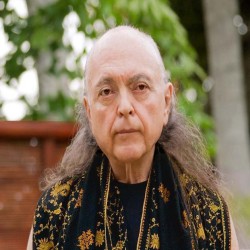
Adi Da
| Date of Birth | : | 03 Nov, 1939 |
| Date of Death | : | 27 Nov, 2008 |
| Place of Birth | : | Queens, New York, United States |
| Profession | : | Writer, Artist, Spiritual Teacher |
| Nationality | : | American |
Adi Da Samraj was an American-born spiritual teacher, writer and artist.He was the founder of a new religious movement known as Adidam.
Biography
Born in Queens, New York and raised on Long Island, his father was a salesman and his mother a housewife. Adi Da claimed in his autobiography, The Knee Of Listening, that he "was born in a state of perfect freedom and awareness of ultimate reality", which he called the "Bright", and that he "sacrificed that reality at the age of two, so that he could completely identify with the limitations and mortality of suffering humanity" in order to discover ways to help others "awaken to the unlimited and deathless happiness of the Heart". A sister, Joanne, was born when he was eight years old. He served as an acolyte in the Lutheran church during his adolescence and aspired to be a minister, but after leaving for college in the autumn of 1957, expressed doubts about the religion to his Lutheran pastor. Adi Da attended Columbia University where he graduated in 1961 with a bachelor's degree in philosophy. He went on to complete a master's degree in English literature at Stanford University in 1963, under the guidance of novelist and historian Wallace Stegner. His master's thesis was "a study of core issues in modernism, focused on Gertrude Stein and the leading painters of the same period".
During and after his postgraduate studies, Adi Da engaged in an experiment of exhaustive writing, a process in which he wrote continuously for eight or more hours daily, as a kind of "yoga" where every movement of conscious awareness, all experiences, internal or external, were monitored and recorded. In this exercise, he felt that he discovered a structure or "myth" that governed all human conscious awareness, a "schism in Reality" that was the "logic (or process) of separation itself, of enclosure and immunity, the source of all presumed self-identity". He understood this to be the same logic hidden in the ancient Greek myth of Narcissus, the adored child of the gods, who was condemned to the contemplation of his own image and suffered the fate of eternal separateness. He concluded that the "death of Narcissus" was required to fulfill what he felt was the guiding purpose of his life, which was to awaken to the "Spiritually 'Bright' Condition of Consciousness Itself" that was prior to Narcissus, and communicate this awakening to others.
In the context of this exploration of consciousness in 1963, Adi Da experimented with various hallucinogenic and other drugs. For 6 weeks he was a paid test subject in drug trials of mescaline, LSD, and psilocybin conducted at a Veterans Administration hospital in California. He wrote later that he found these experiences "self-validating" in that they mimicked ecstatic states of consciousness from his childhood, but problematic as they often resulted in paranoia, anxiety, or disassociation. While living with the support of his girlfriend, Nina Davis, in the hills of Palo Alto, he continued to write, meditated informally, and studied books by C.G. Jung, H.P. Blavatsky, and Edgar Cayce, in order to make sense of his experiences.
Quotes
A bargain is something you don't need at a price you can't resist.
Death is utterly acceptable to consciousness and life.
The nature of the world is inherently obvious, if you remain in a state of total psycho-physical oneness with whatever and all that presently arises.
Without true celebration discipline is obnoxious.
